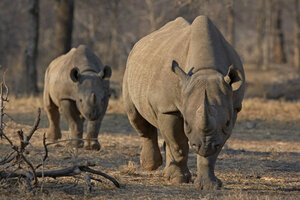Body cams for rhinos? New gear catches poachers red-handed
A new tracking device and alarm system could be a valuable tool in the 'increasingly desperate' struggle to save rhinos from extinction.

An endangered east African black rhinoceros and her calf walk in Tanzania's Serengeti park in this file photo taken May 21, 2010. Protect, a UK-based conservation company, has developed a system of technologies designed to alert and dispatch anti-poaching teams whenever a rhino is threatened.
Tom Kirkwood/Reuters/File
In the struggle to save rhinos, conservationists have used a range of strategies against the ever-present poacher: information, legislation, even military intervention.
The latest method involves a new gadget called RAPID, short for Real-time Anti-Poaching Intelligence Device. Essentially a rhino body camera hooked up to a GPS satellite collar and a heart-rate monitor, the device – developed by UK-based conservation company Protect – broadcasts real-time, 24/7 footage to a control center, allowing anti-poaching teams to be alerted and dispatched within seconds of a poaching event taking place.
Think Crocodile Hunter meets Big Brother.
"The heart rate monitor triggers the alarm the instant a poaching event occurs, pinpointing the location within a few meters so that rangers can be on the scene via helicopter or truck within minutes," Dr. Paul O’Donoghue, chief scientific advisor for Protect, said in a statement. This leaves poachers "with no time to harvest the valuable parts of an animal or make good an escape."
He added, "You can’t outrun a helicopter."
The rhino population has fallen from 500,000 animals at the turn of the 20th century to 70,000 in 1970 and to under 30,000 today – a result of the dramatic rise in poaching, driven by the illegal trade for rhino horn, according to nonprofit Save the Rhino. South Africa, home to the world’s largest rhino population, has seen poaching surge from 13 animals in 2007 to more than 1,200 in 2014.
In 2011, the International Union for Conservation of Nature (IUCN) declared the Western black rhino extinct. If the killing continues, conservationists warn, other rhinoceros species may soon follow.
"If we don’t stop the Asian demand for rhino horn, elephant ivory, and lion bone, the big game in Africa is doomed," Brian Gaisford, president of Hemingway Gallery and Safaris in New York, told Forbes in June. "Everyone involved in the fight to save the rhino agrees on one thing: the situation is not looking good for rhinos."
Conservationists have fought back with a wide arsenal of techniques, from educating the public, to coating rhino horns with a non-lethal poison to deter consumer demand, to developing 3D-printed rhino horns to drive down prices in the market.
The world’s last remaining male white rhino even has an armed security detail for protection.
But most of these solutions have failed to slow the poaching, Protect director Steve Piper said in an email to The Christian Science Monitor.
"Evidence suggests that poisoned rhino horns are still poached and still purchased on the black market. Awareness campaigns tend to focus in Western countries like the US or UK where there is little demand for these things whilst ignoring the more hungry markets in Asia, and no matter how strong the legislation, the monetary value is so great people will still take the risk," Mr. Piper wrote.
By weight, rhino horn is about 50 percent more valuable than gold and illegal drugs, he said. A kilogram (2.2 pounds) retails for about $65,000, he continued.
The money has lured sophisticated transnational crime organizations into the poaching game.
"[O]rganized crime networks and groups have identified the massive profits to be made [in poaching], and so they’re taking over control," John Sellar, former head of law enforcement for the Convention of International Trade in Endangered Species of Wild Fauna and Flora (CITES), told National Geographic in May.
And increasingly, poachers’ methods reflect that kind of organization: "You use sophisticated smuggling techniques to move [the product] across borders, or bribe shipping companies and bribe customs officials or border officials," Mr. Sellar said. "You bribe park rangers, you bribe policemen."
RAPID’s developers seek to tackle at least part of that network. The GPS collar and heart-rate monitor are placed under the rhino’s skin, while the camera is drilled the animal’s horn – a painless process, as the horn is made of keratin, the same stuff that makes up fingernails and hair.
Should a sudden or drastic change occur in the rhino’s heart rate, as would happen if the animal was shot, the camera will switch on and an alarm would send anti-poaching teams to the scene, according to the device’s proof of concept, published in April in the Journal of Applied Ecology. Not only will it help catch poachers in the act, but any video captured can later help prosecute them.
Already a number of individuals and organizations, including Humane Society International, have voiced support for the device. While acknowledging that RAPID is not the final solution to the poaching scourge, they have noted its potential.
"Reducing market demand is critical to safeguard wildlife long term, but it needs to be coupled with urgent, effective action to stop the current poaching crisis," Claire Bass, executive director of Humane Society UK, said in a statement.
"RAPID could be a game changer in the increasingly desperate fight against poaching, and the technology has the potential to be applied to other critically endangered species, including tigers and elephants," she said.
Developers are currently focused on finding sponsors and funders to produce RAPID and deliver it to the field at the lowest cost possible, Protect’s Piper said. The first prototypes for rhinos should be out in a few months, and the company hopes to have a fully functional control center by next year.

